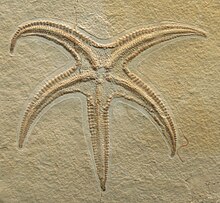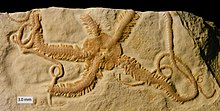Asterozoa
| Asterozoa | |
|---|---|

| |
| A brittle star on a starfish | |
| Scientific classification | |
| Domain: | Eukaryota |
| Kingdom: | Animalia |
| Phylum: | Echinodermata |
| Subphylum: | Asterozoa von Zittel, 1895[1] |
| Classes[2] | |
| |
| Synonyms | |
| |
The Asterozoa are a subphylum in the phylum Echinodermata, within the Eleutherozoa. Characteristics include a star-shaped body and radially divergent axes of symmetry. The subphylum includes the class Asteroidea (the starfish), the class Ophiuroidea (the brittle stars and basket stars), and the extinct taxa Somasteroidea and Stenuroidea.[2]
Taxonomy
[edit]Originally proposed in the late 1800s, Asterozoa was not used in F.A. Bather's two-subphylum echinoderm taxonomy in 1900. However, it was adopted as part of a four-subphylum taxonomy by the Treatise on Invertebrate Paleontology in 1966.[4]
Asterozoa is a monophyletic clade; its sister group is Echinozoa.[5]
Asteroidea
[edit]
Members of the class Asteroidea are characterised by a star-shaped body plan consisting of a central disc and multiple radiating arms. They usually exhibit pentamerous radial symmetry, but some species typically have a symmetry based on a number other than five. The arms have very broad bases and their skeletal support is provided by the calcareous plates called ossicles or ambulacral plates in the body wall. These are joined with muscular and connective tissue giving flexibility. The mouth is on the lower or oral surface, with a corresponding anus on the upper or aboral surface; though the anus is absent in Paxillosida, wherein the mouth serves also as an anus, otherwise leading to a blind gut, similar to their Ophiuroid relatives. Their large coelomic cavity can extend from the disc into the arms. The paired gonads are also located in the arms and release gametes via the gonoducts. The lateral flexion of the arms is limited by how the ambulacral plates are arranged. On the oral surface of the disc and radiating arms are four rows of ambulacral plates which are associated with two or four rows of tube feet, which are used in locomotion. On the upper or aboral surface of the disc is an opening, the madreporite. This is connected to the water vascular system which assists in respiration and provides hydraulic pressure for the tube feet.[6]
Ophiuroidea
[edit]
Members of the class Ophiuroidea are characterised by having the gut and internal organs confined to the central disc. The arms are clearly separated from the disc. The tube feet do not have adhesive properties, but serve a sensory function. In all the extant genera, the ambulacral plates are fused in pairs and form joints in the arms, known as vertebrae. In some extinct genera, they are not fused in this way. The ambulacral grooves function as internal epineural canals.[7]
Somasteroidea
[edit]All members of the order Somasteroidea (or Stomasteroidea) are extinct. Their first appearance in the fossil record was in the early Ordovician and they had probably died out by the late Devonian. They are similar to the asteroids in that their bodies are flattened dorsoventrally and they have five petaloid arms with broad bases. The ambulacral plates in somasteroids are simple and unspecialized, and the arms were thought to be not flexible and were unable to assist in feeding, but the oral mouth parts were more complex.[8] An example for Somasteroidea is Villebrunaster fezouataensis.
Stenuroidea
[edit]Stenuroidea is an extinct taxon that has been given class rank by some authors. It is believed to be paraphyletic.[2]
References
[edit]- ^ K. A. von Zittel. 1895. Grundzuge der Palaeontologie 1-971
- ^ a b c Nanglu et al. 2023, p. 331
- ^ Spencer & Wright 1966, p. U39
- ^ Spencer & Wright 1966
- ^ Escriva et al. 2015
- ^ Asteroidea Tree of Life Web Project. Retrieved 2011-09-29.
- ^ Class Asterozoa — Subclass Ophiuroidea Synoptic Keys to the Genera of Ophiuroidea. Retrieved 2011-09-29.
- ^ Somasteroidea Tree of Life Web Project. Retrieved 2011-09-29.
Works cited
[edit]- Escriva, Hector; Reich, Adrian; Dunn, Casey; Akasaka, Koji; Wessel, Gary (2015). "Phylogenomic Analyses of Echinodermata Support the Sister Groups of Asterozoa and Echinozoa". PLOS ONE. 10 (3): e0119627. Bibcode:2015PLoSO..1019627R. doi:10.1371/journal.pone.0119627. PMC 4368666. PMID 25794146.
- Nanglu, Karma; Cole, Selina R.; Wright, David F.; Souto, Camilla (2023). "Worms and gills, plates and spines: the evolutionary origins and incredible disparity of deuterostomes revealed by fossils, genes, and development". Biological Reviews. 98: 316–351. doi:10.1111/brv.12908.
- Spencer, W. K.; Wright, C. W. (1966). "Asterozoans". In Moore; Raymond C. (eds.). Treatise on Invertebrate Paleontology, Part U: Echinodermata 3. Vol. 1. University of Kansas Press. pp. U5–U107. Retrieved 28 October 2024.
